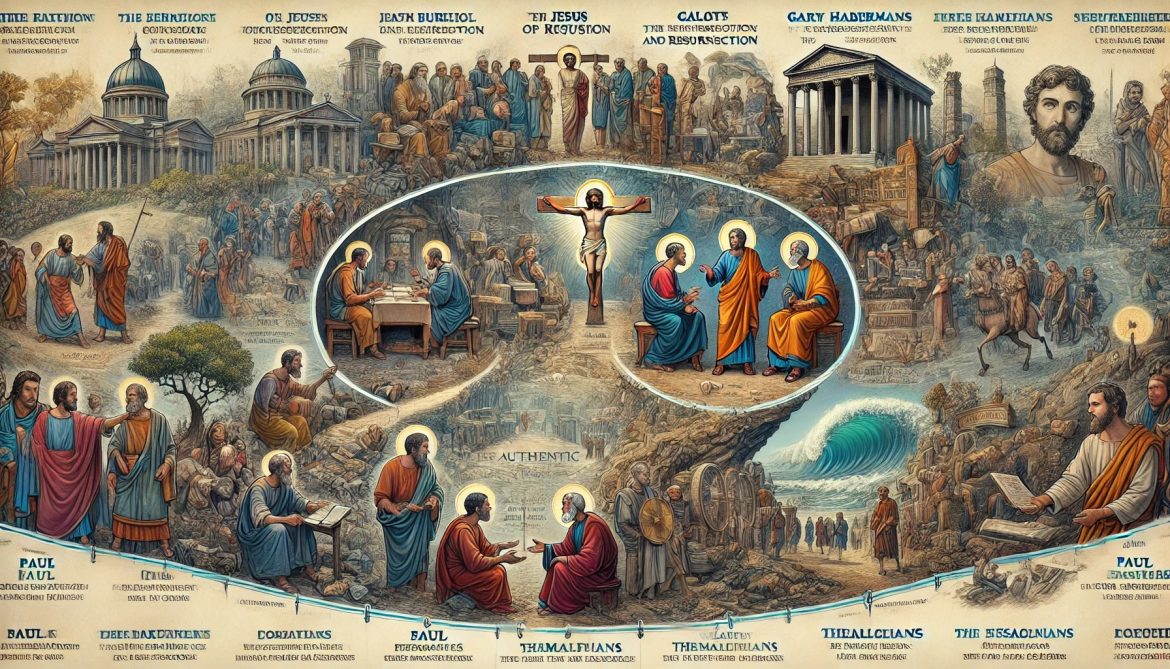Introduction
This phrase will have virtually no disputants in the contemporary world: Jesus’s earliest followers had experiences that they thought were appearances of the risen Jesus. Virtually nobody disputes that. Bart Ehrman says, “No, I don’t dispute that. It’s determined historically. We know it’s true. Why would I say I dispute it? It’s just true,” says Jaiden Forrest.
The Historical Argument
The argument that you’re about to hear for the case for the risen Jesus changed a generation of how scholars think about this issue. Dr. Gary Habermas, a New Testament scholar, dishes out cold, hard historical facts for the resurrection of Jesus that even Bart Ehrman admits to, as you’ll hear about later. I will save most of my commentary for the end, but to save you time, we’re going to be jumping around a lot in this argument, and I’m going to fill you in as we go along.
Scholarly Consensus on Paul’s Writings
First, he establishes whether or not scholars trust the reliability of the Apostle Paul’s writings, which will be important for later. Let’s get into it. Which of these books do they accept by Paul? Well, almost unanimously, they always accept the same books. It’s not like some scholars accept one half and somebody else accepts the other half. They will always accept Romans, First and Second Corinthians, Galatians, Philippians, First Thessalonians, and of course, Philemon. But that’s a one-chapter, non-theological book, not terribly helpful. But the other ones, Romans, First and Second Corinthians, Galatians, Philippians, First Thessalonians, are crucial.
Bart Ehrman, probably the best-known skeptic in America—he calls himself an agnostic leaning toward atheism and the foremost skeptical New Testament scholar in this country—says these are the authentic Pauline Epistles. No one’s going to give you problems if you use this material. Now, does that mean everything Paul wrote was true? No. Does that mean Paul was inspired? No. What does it mean? It means he was in the right place at the right time. We know who he was. He’s a scholar. He was changed by this message. So, there’s some dynamics there that are worthwhile. He’s just somebody who knew what was going on at that time. And very importantly, as you’ll see in this lecture, he knew the other people who knew what was going on. He knew the other eyewitnesses. So that’s what authoritative means—not always right, but scholarly and in a position to be right, and we know who he is.
Historical Reliability of Galatians and 1 Corinthians
It’s especially important to note here that scholars take Galatians and First Corinthians to be historically reliable texts. This is important because these texts outline the historical account of the eyewitnesses to the resurrection of Jesus in a timeline of the life of Paul, which is important for later. At this time, most scholars saw the historical case for Jesus to be pretty unreliable because a lot of the source texts that we have for this, like the gospels of Matthew, Mark, Luke, and John, are dated 30, 40, 50, even 60 years after the death of Jesus. But in the argument that you’re about to hear, it brought about a case where scholars could not deny the fact that material for the resurrection of Jesus came one to two years following the death of Jesus on the cross, some scholars even saying within six months of the death of Jesus.
The Minimal Facts Argument
I’m going to drop this second argument that says the New Testament is in the right place at the right time and fulfills the criteria for historiography. Now, from this point on, I’m going to be doing my minimal facts argument. I’m going to be citing only data—probably 95% of what I say from now on will be accepted across the critical spectrum from conservative scholars to atheist scholars who study these disciplines. All are going to agree with almost everything I’m saying here.
What makes Bart Ehrman say that we can get Paul’s report from just plus 25? What makes Bart Ehrman say that we’ve got plenty of material from one to two years after the cross? How in the world can a guy who is, quote, an agnostic leaning toward atheism, say we can get this material back to plus one or plus two?
Dating Paul’s Writings
All right, so Paul is writing here. First Corinthians 15. There’s no difference on the date. Some people might say 53; some people might say 57, but it’s not determined by whether you’re conservative or liberal or whatever. About 55, a nice round 25 years. But Paul says in the first two verses, “When I came to you, Corinthians, this is the message I gave you.” In other words, when he came to them, he said it, and now he’s writing it down. When did he come to Corinth? Some people think that this is the most ascertainable date in the entire New Testament: 51 AD. 51 to 52. How do we know that? Well, because the New Testament mentions a city leader who was in control of Corinth when Paul came to Corinth, and an inscription has been found in stone with this guy’s name on it. How convenient! These city leaders—city-states, remember, in Greece—were chosen for one-year terms, and it’s known that he ruled the city from 51 to 52 AD. When Paul came, he was in control.
All right, so Paul says, “I’m writing to you here what I said to you here at plus 21.” And he says in verse three again, “I gave you what I was given as of first importance.” We’re talking about the heart of Christianity right now. He says, “And I’m telling you what I was told.” Okay, interesting. Here’s the question: When and from whom did he receive this material? Do we have a clue when and from whom he received this material?
Paul’s Encounter with the Apostles
Let me give you the scholarly, the critical conclusion. Bart Ehrman is going to agree with this. People who don’t even think Jesus lived—which are like… Ehrman just wrote a whole book against them, saying, “You guys don’t have credentials. You’re out of your field. Stay in your own field.” That’s a skeptic writing to the skeptics. It’s kind of a fun read. I have to tell you about their arguments. But virtually everybody—virtually everybody—Richard Bauckham, Cambridge University, says this is a consensus position among scholarship. They believe Paul received this material about 35 AD. Plus five? Yeah, plus five. How in the world would they know that? Let’s do the math.
Chronology of Paul’s Conversion and Visits to Jerusalem
Here’s the cross. We’re calling it, for a nice round number, 30 AD. When did Paul have his Damascus Road experience, or for skeptics, when did Paul think Jesus appeared to him on the road to Damascus? It was either plus two or plus three. Paul says in Galatians chapter 1, an authoritative book according to the definition I gave you earlier of authoritative, Galatians chapter 1, Paul says, “I met Jesus,” and then he said, “I didn’t go running up to Jerusalem to meet those who were apostles before me. I went out into Arabia by myself for three years.” Now, some people think he was preaching and all kinds of other stuff, but we really don’t know. He said, “I went off for three years and then I went up to Jerusalem.”
All right, again, let’s do the math. Here’s the cross. When does Paul come to the Lord? Plus two. You say, “I think it’s plus three.” Great. Plus three. Three years later, he goes up to Jerusalem. Three plus three, six. 30 AD. “Oh, I think he was converted in 32 AD.” Okay, great. Two plus three, 35. And in Galatians chapter 1, Paul says, “I went up to Jerusalem after three years.” So we’re plus five or plus six after the cross. And Paul says, “I spent 15 days with Peter, the head apostle. I saw no others, no other apostles, except James, the brother of Jesus.” Then, as we go from the end of Galatians 1 into Galatians 2, no chapter break, he says, “14 years later, I went back.”
Verifying the Consistency of the Gospel
All right, 14 years later, I went back. Critics like Bart Ehrman and Helmut Koester at Harvard put this event at about 48 AD. We’re still only plus 18. He went back. In Galatians 2:2, one of the most incredible verses in the New Testament, I love the way the King James translates it here, but most translations say just about the same thing. Paul says in Galatians 2:2, “I went back up after 14 years to see the other apostles and to set before them the gospel I was preaching, to see if I was running or had run in vain.” What? Yeah, “I went back up to Jerusalem to make sure we were all on the same page, to make sure we were all presenting the same gospel.” Neat. So we do want to make sure that you guys were preaching the same thing. Galatians 2:2, “I went back up there. I shared with them the gospel I was preaching.” And then just a few verses later, Galatians 2:6, these five words in English: “They added nothing to me.” They added nothing to me. Then, just three verses later, they—this is where we get the phrase—laid hands on Barnabas and me, and they gave us the right hand of fellowship. And they said, “Y’all go to the Gentiles and take this message. We’re going to stay here and give the message to the Jews.” But the point is, the message was the same. They added nothing to me.
The Early Creed and Its Implications
All right, one more thing and I’m done. So far, I’ve been focusing on this point right here, at five to six years after the cross. But I’m going to assert that we can get back all the way to the cross. We can close this gap. Why does Bart Ehrman—what I started with—why does Bart Ehrman say we can get this message back to one to two years after the cross? Why does he concede that? Why do skeptics—why has the table certainly totally changed on this? Because of this creedal argument. In the New Testament, they can tell that this was early preaching. This is what the earliest apostles preached coming out of the gate. All right, this is when Paul heard the message. Historia, Galatians 1:18. This is when he did the firsthand research.
The Early Creed’s Structure and Memorization
Now, if Peter and James gave it to Paul, they had it before he had it. Now, when I say an early creed, one of the reasons they know it’s an early creed is because in the Greek, it reads stylistically. First Corinthians 15:3 and following reads like this in the Greek: Two stanzas with data, and not a rhyming sequence like English, but a way that’s easily memorizable. Why? Because most New Testament scholars today believe that the vast majority of Jesus’s audiences, contrary to other things you may have heard, were illiterate—up to 90%. What do you do when you teach somebody who’s illiterate but you want them to teach somebody else? You tell stories that they’ll remember—ah, parables—and you give them short, pithy statements that they will memorize: “Turn the other cheek,” “Walk the extra mile,” “Do unto others.” And when you codify things into a, especially if there’s an Aramaic original, which is the language Jesus speaks, now we know you’re really going back in the church because somebody had to put this together.
All right, Paul hears it; they had it before Paul. Someone had to codify it. You had to get it from the events, and we’re right on top of it. Many things in the ancient world depend on one witness, and two make an event unimpeachable. Two, Bauckham says, we have 11 different sources, historical sources, for the crucifixion of Jesus.
Historical Sources for the Crucifixion
So, here’s what you get. Bottom line: This phrase will have virtually no disputants in the contemporary world. Jesus’s earliest followers had experiences that they thought were appearances of the risen Jesus. Virtually nobody disputes that. Bart Ehrman says, “No, I don’t dispute that. It’s determined historically. We know it’s true. Why would I say I dispute it? It’s just true.” And we don’t need Paul’s writings to prove what he’s saying. We have 11 independent sources that even Bart Ehrman and the rest of modern academia agree on, which are: Josephus, Tacitus, Mara Bar-Serapion, Suetonius, the Talmud, Pliny the Younger, Lucian, Thallus, Celsus, the Dead Sea Scrolls, and the James Ossuary.
Conclusion
We can’t run from the historical fact that Jesus died on a cross in 30 or 33 AD and that Jesus’s early followers really did think that the risen Christ appeared to them. They were willing to die for this fact and testify for it and be martyred—some of them in horrible deaths, being burnt alive, crucified on crosses, and stoned to death. Human psychology says that people are not willing to die for something that they know to be a lie. We can verify the historical accounts of these people dying for the fact through the early church fathers like Tertullian, Polycarp, and Origen of Alexandria, and the early historians such as Josephus and Eusebius. But even so, what we can do is try and come up with an alternative explanation that explains these facts without a supernatural element.
One of the prevailing theories we have here is the hallucination theory, which basically says all these people who had appearances of Jesus, or at least thought they saw him, had hallucinations, temporary delusions, something of that sort. But the main flaw with this theory is that there are times when Jesus appeared to groups of people at the same time. And if we look at the clinical studies about hallucinations, we find that when people experience hallucinations, people never have the same hallucination in a group at the same time together. Hallucinations are individual, subjective experiences. Even when groups of people are together and hallucinate at the same time, they have their own subjective experiences, and their hallucinations are different—they are not all the same. If we couple this also with the fact that Jesus appeared to different people over a span of weeks, from different personalities, different backgrounds, different ways of thinking, and different social classes, and they all testified to the same thing, it strengthens the argument.
Even if we find a way to rationally fit these flaws with the theory in a way that makes sense, we also have to figure out how this fits in with the empty tomb because Jesus’s tomb was empty. We have to find the most reasonable explanation for all this. Given the facts that we have about the historical Jesus, I think it’s most reasonable that the evidence points to Jesus really rising from the dead and appearing to these people, but this is not an airtight argument. This doesn’t prove Jesus or God, yet it gives you foundation understanding to better know Him and the authority of scripture. This should strengthen your faith in the Truth!
Source: Jaiden Forrest and Dr. Gary Habermas




